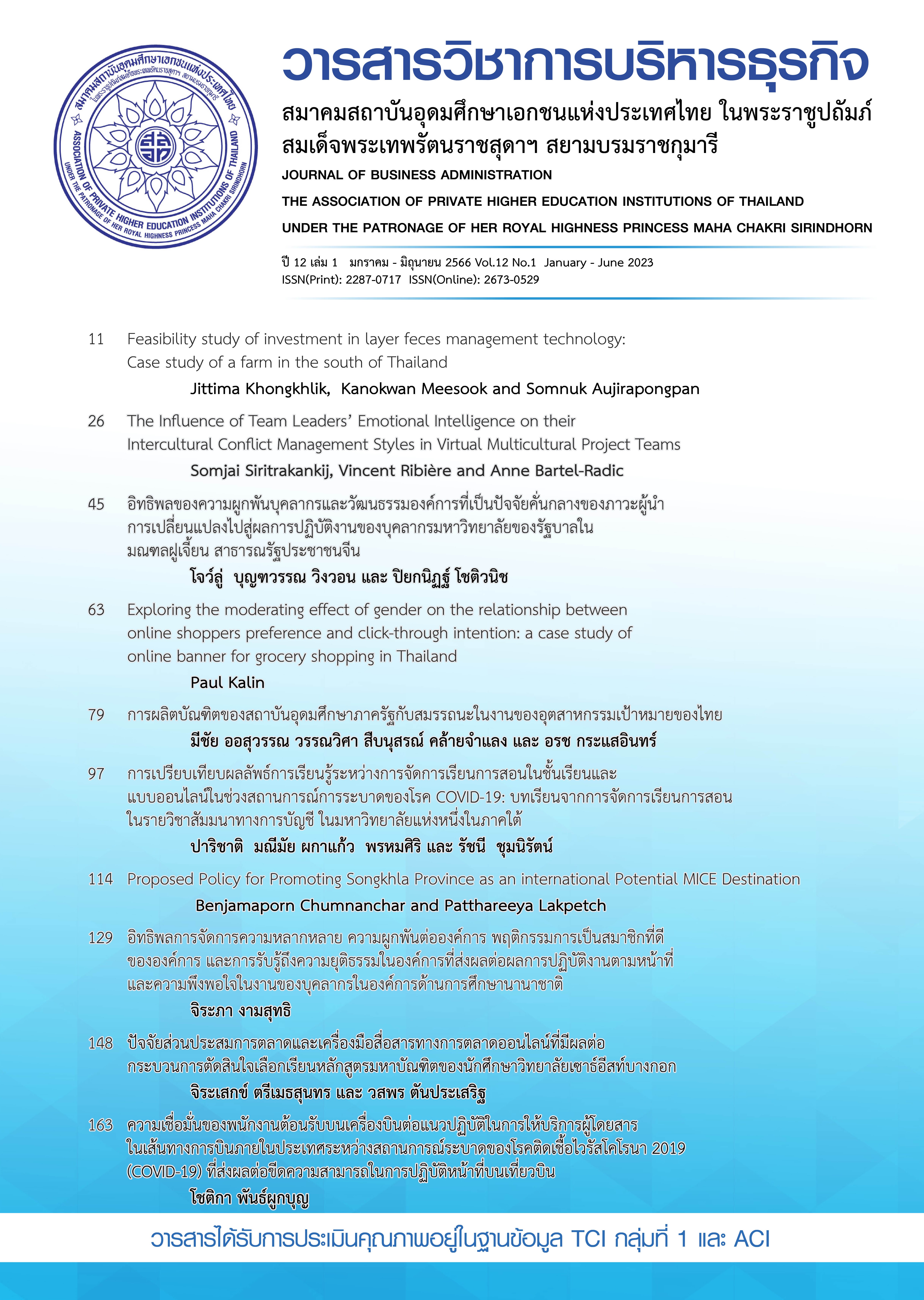Producing Graduates of Public Higher Education Institutions and Job Competencies of Thailand’s Target Industries
Keywords:
Higher Education, Target Industry, Workforce,, TQF:HEdAbstract
What will future jobs look like? What skills do these jobs require? Has the university taught these skills to students yet? This research was funded by Thailand Science Research and Innovation Fund. It explored the alignment between worker proficiencies and workforce needs required by the 10 target industries, including biofuels and biochemical, digital, medical hub, robotics and automation, aviation and logistics, agricultural and biotechnology, food for the future, next-generation automotive, smart electronics and affluent medical and wellness tourism. This research had two main objectives. First, the researchers asked a group of experts to confirm and rank the job skills and competencies previously surveyed by the National Science Technology and Innovation Policy Office and the Office of National Higher Education Research and Innovation Council. Second, the research examined whether or not college training aligned student skills with the job skills needed by the target industries. Third, this research recommended that higher education institutions and the private sector should work together to produce graduates that possess specific job competencies of Thailand’s target industries.
Based on an in-depth content analysis of 1,532 public university course materials (TQF:HEd), 34 in-depth interviews and focus-group interviews with 97 stakeholders, this research had three findings. First, the stakeholders agreed with MHESRI’s job skills assessment results for the most part (except for jobs in the robotics industry). They also ranked the 5 top in-demand skills in each industry. Second, the educational outputs on the supply and demand sides are overlapping. Universities need to align their curricula with the job market’s requirements and help their students close the gaps in their job skills. Finally, this research suggested a guideline for “increase”, “decrease”, “cut” and “build” certain components of the curriculum, regulations and mechanisms for upgrading Thai graduates’ competencies to meet the labor needs of target industries.
References
Altbach, P.G., Reisberg, L., & Rumbley, L.E. (2009). Trends in global higher education: Tracking an academic revolution. UNESCO. https://unesdoc.unesco.org/ark:/48223/pf0000183219
Care, E., Vista, A., & Kim, H. (2017). Assessment of transversal competencies: Current tools in the Asian region. https://bangkok.unesco. org/ content/assessment-transversal-competencies-currenttools-asian-region
Independent Committee for Education Reform. (2019). A report on the mission of educational reform in Thailand. http://backoffice.onec.go.th/uploads/Book/1734-file.pdf
Hemavajirakorn, N. (2021, Feb 8). The end of school. https://www.efinancethai.com/MoneyStrategist/MoneyStrategistMain.aspx?id=eEt1MEJxSXZESzg9
Kaufman, R.A., & Guerra-Lopez, I. (2013). Needs assessment for organization success. ASTD Press
Leydesdorff, L., & Etzkowitz, H. (1996). Emergence of a Triple Helix of university—industry—government relations. Science and public policy, 23(5), 279-286.
National Science Technology and Innovation Policy Office (2017). Strategy for sciences, technology and innovation development for 10 target industries for 20 years (2017-2036). http://www.sti.or.th/sti/uploads/comtent_pdf/46_TH.
National Statistical Office. (2022). The labor force survey whole Kingdom: Quarter 1 (January - March 2022). http://www.nso.go.th/sites/2014en/Survey/social/labour/LaborForce/2022/fullreport_q1_2022.pdf
Office of National Higher Education Science Research and Innovation Policy Council. (2022). Future worker’s competencies for 12 target industries (2020 – 2024). https://www.nxpo.or.th/th/report/5532/
Organisation for Economic Co-operation and Development. (2019). The future of education and skills 2030: OECD learning compass 2030: A series of concept notes. OECD.
Office of the National Economic and Social Development Council. (2020). Social situation and outlook. https://www.nesdc.go.th/ewt_dl_link.php?nid=10933
Office of the National Economic and Social Development Council. (2021). Social situation and outlook. https://www.nesdc.go.th/ewt_dl_link.php?nid=5491
O*NET. (2022). National center for development. www.onetonline.org/find/all
Pholphirul, P. (2017). Educational mismatches and labor market outcomes: Evidence from both vertical and horizontal mismatches in Thailand. Education and Training, 59(5), 534-546. doi: https://doi.org/
1108/ET-11-2016-0173
Rattanakhamfu, S. (2022). Improving Thailand’ s labor force to meet the disruptive world. https://tdri.or.th/wp-content/uploads/2022/02/wb184.pdf
Senkrua, A. (2015). The mismatch in Thai labor market: Overeducation. Journal of Economics, Journal of Economics, 19(1), 92-116.
Taleb, N. N. (2007). The black swan: The impact of the highly improbable (Vol. 2). Random house.
UNICEF. (2019). Comprehensive life skills framework: Rights based and life cycle Approach to building skills for empowerment. https://www.unicef.org/india/media/2571/file/Comprehensive-lifeskills-framework.pdf
Wongwanich, S. (2015). Needs assessment research. Chulalongkorn University Press.
World Bank. (2016). Education global practice smarter education systems for brighter futures: SABER tertiary education. https://documents1.worldbank.org/curated/en/110781492506918681/pdf/114293-ARPUBLIC-SABER-Annual-Report-2-14-17-web.pdf
World Economic Forum. (2020a). Jobs of tomorrow: Mapping opportunity in the new economy. https://www3.weforum.org/docs/WEF_Jobs_of_Tomorrow_2020.pdf
World Economic Forum. (2020b). The future of jobs report 2020. https://www3.weforum.org/docs/WEF_Future_of_Jobs_2020.pdf
Wucker, M. (2016). The gray rhino: How to recognize and act on the obvious dangers we ignore. Macmillan.
Zerubavel, E. (2006). The elephant in the room: Silence and denial in everyday life. Oxford University Press.

Downloads
Published
How to Cite
Issue
Section
License
Copyright (c) 2023 Journal of Business Administration The Association of Private Higher Education Institutions of Thailand

This work is licensed under a Creative Commons Attribution-NonCommercial-NoDerivatives 4.0 International License.
บทความที่ลงตีพิมพ์ในวารสารวิชาการบริหารธุรกิจ สมาคมสถาบันอุดมศึกษาเอกชนแห่งประเทศไทยต้องเป็นบทความที่ไม่เคยได้รับการตีพิมพ์เผยแพร่ หรืออยู่ระหว่างการพิจารณาตีพิมพ์ในวารสารอื่นๆ การละเมิดลิขสิทธิ์เป็นความรับผิดชอบของผู้ส่งบทความโดยตรง

